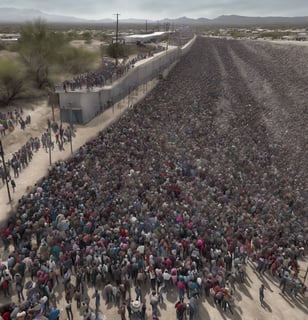The 2024 US-Mexico Border Migration Crisis
Causes, Challenges, and Controversies
2/11/20242 min read


1. Record Levels of Migration
The numbers speak for themselves. Over the past three years, the number of people attempting to cross the US’s southern border has reached staggering heights. In December 2023 alone, border patrol agents recorded 302,000 encounters, which includes apprehensions and immediate expulsions. To put this in perspective, the monthly average from 2013 to 2019 was only 39,000.
2. Global Factors at Play
Several global factors contribute to this surge in migration:
Global Instability: People worldwide are fleeing war, political insecurity, violence, poverty, and natural disasters. The US remains an attractive destination for those seeking safety and opportunity.
Joe Biden’s Presidency: The timing coincides with President Joe Biden’s tenure. His administration has taken a more compassionate approach to immigration, which some argue has encouraged more people to attempt the journey.
3. Changing Origin Countries
While Mexico remains the single most common origin country for US border encounters, the landscape has shifted. In 2023, Mexican nationals accounted for less than 30% of total encounters, compared to over 60% a decade ago. Other countries, particularly those in Central America, have seen gains in their share of encounters. Nations like Guatemala, Honduras, and El Salvador contribute significantly to the flow of migrants.
4. Perilous Journeys and Humanitarian Concerns
The journey for migrants attempting to reach the US is fraught with danger. They face treacherous terrains, human traffickers, and extreme weather conditions. The notorious Darién Gap, a dense jungle at the southern end of Central America, poses a significant challenge. Efforts to stop migrants from crossing this gap have led to outcry, as many are left stranded or face life-threatening situations.
Tragically, nearly 9,000 people have been recorded missing or dead in the Americas over the past 10 years. These are human lives lost in pursuit of safety and a better future.
5. Government Response and Political Divides
The surge in migration has strained government resources and divided Congress. The Biden administration faces immense pressure to address the crisis effectively. Critics argue that lax immigration policies have contributed to the situation, while others emphasize the need for compassion and humanitarian assistance.
As the 2024 presidential campaign unfolds, immigration remains a contentious issue. Americans overwhelmingly fault the government for how it has handled the migrant situation. Balancing border security, humanitarian concerns, and political realities is no easy task.
6. The Chinese Factor
Amidst this complex situation, there is growing concern about the involvement of Chinese nationals. Reports suggest that some Chinese migrants are also attempting to cross the US-Mexico border. Their motivations vary, including economic opportunities, political reasons, and family reunification. However, the presence of Chinese migrants adds another layer of complexity to an already multifaceted crisis.
Conclusion
The US-Mexico border migration crisis is multifaceted, with no simple solutions. It requires a comprehensive approach that considers both security and compassion. As policymakers grapple with the complexities, the lives of thousands of migrants hang in the balance, seeking safety and hope on the other side of the border.
Disclaimer: The information provided here is based on available data as of February 2024 and reflects the situation at that time. The crisis is dynamic, and developments may occur beyond this timeframe.
